
Film language
Schede di sintesi - Outlines
 |
Il linguaggio cinematografico Film language Schede di sintesi - Outlines |
Altri aspetti della ripresa Le dissolvenze Che cos'è un dramma se non la vita senza i momenti noiosi? Alfred Hitchcock In un certo senso, un film è un concentrato di vita, a cui sono stati tolti tutti i passaggi monotoni e noiosi: se vediamo un uomo alzarsi dal letto, farsi una doccia e poi uscire di casa, intuiamo che molte altre azioni sono state "saltate": farsi la barba, vestirsi, fare colazione, ecc. Queste ellissi, cioè le omissioni che lo spettatore può facilmente intuire, salvaguardano il ritmo del film eliminando, appunto, le parti noiose e "scontate". Una delle tecniche più tradizionali per realizzare ellissi è la dissolvenza, in entrata (dallo schermo nero appare gradualmente l'immagine) o in uscita (l'immagine gradualmente sparisce nello schermo nero). |
Other aspects of shooting Fading in, fading out What is drama but life with the dull bits cut out? Alfred Hitchcock In a way, a film is the essence of life, where all the dull and boring moments have been cut out: if we see a man get up from his bed, have a shower and then leave home, we take it for granted that several other actions have been "deleted": shave, dress, have breakfast, and so on. These ellipses, i.e. the parts that have been omitted, but which the audience can easily reconstruct, preserve the rhythm of the film by deleting the dull and "obvious" moments. One of the most traditional ways to use ellipses is fading, either "in" (the image gradually emerges from a black screen) or "out" (the image gradually disappears into a black screen). |
|
Spesso la dissolvenza viene incrociata:
a un'immagine si sostituisce quella successiva, e per qualche istante le
due immagini si sovrappongono. In (1), le due persone si avviano verso
l'auto e successivamente, tramite una dissolvenza incrociata, le
ritroviamo in viaggio: chiaramente intuiamo che siano saliti in auto,
che l'uomo abbia acceso il motore, che abbia preso una certa strada,
ecc.: tutte azioni che non ci vengono mostrate. La tradizione vuole anche che la dissolvenza (incrociata) possa anche introdurre un flashback, cioè un ricordo o una rievocazione di un avvenimento passato, come in (2). Altre forme di dissolvenza, come l'iride in apertura e/o in chiusura (3), sono state molto usate per lungo tempo nel cinema muto. Con una serie di dissolvenze si ottiene l'effetto di ellissi reiterate:ad esempio, con immagini ripetute di diversi giornali in rapida sequenza si può rendere l'idea del passaggio del tempo; con immagini ripeture di poster che pubblicizzano incontri di boxe o spettacoli musicali si può illustrare la rapida carriera di un pugile o di un musicista. In (4), l'uomo ottiene una lista di pittori da cui potrebbe risalire alla persona che sta cercando. Una serie di dissolvenze, che lo mostrano mentre contatta alcuni dei pittori della lista, sono intervallate dall'immagine delle scarpe dell'uomo che cammina da un contatto all'altro: in questo modo poche inquadrature comprimono il tempo, dando il senso di una ricerca lunga e complessa. Questa serie di dissolvenze termina con una sovrimpressione della lista e del volto dell'uomo, chiaramente frustrato nella sua ricerca. La velocità della ripresa Cambiare il rapporto tra la velocità della ripresa e la velocità della proiezione determina altri effetti particolari: se si riprende a minori fotogrammi al secondo rispetto alla proiezione si avrà un'accelerazione del movimento (fast motion); al contrario, più fotogrammi al secondo vengono ripresi rispetto alla proiezione, più si rallenterà il movimento (slow motion). Un esempio di entrambi gli effetti è visibile qui, mentre per altri esempi di slow motion si vada qui e qui. Forme estreme di accelerazione si hanno nel cosiddetto passo uno (o "ripresa temporizzata" o "a fotogramma singolo")(time-lapse), in cui, ad esempio, si mostra un fiore sbocciare e sfiorire nel giro di pochi secondi (5): si tratta di cinematografia ad altà velocità (si vedano esempi qui e qui). Altri procedimenti speciali Nel processo di retroproiezione, il primo piano di una scena viene ripreso nello studio contro uno schermo sullo sfondo, sul quale viene proiettata, da dietro lo schermo stesso, un'immagine precedentemente filmata . E' il tipico caso di tante riprese di dialoghi in auto (6), e di situazioni in cui la ripresa "reale" potrebbe comportare rischi o semplicemente essere molto costosa. Nell'analogo, e opposto, processo di proiezione frontale, lo sfondo di una scena viene proiettato su uno schermo da un apparecchio posto frontalmente e con l'ausilio di uno specchio, ed anche i personaggi vengono ripresi davanti allo stesso schermo (7). Nel cosiddetto matte process work, è possibile fotografare separatamente parti dell'immagine, unendole poi in laboratorio. Utilizzando appositi mascherini (= matte), si fotografa una parte della scena - ad esempio, l'ambiente - su uno spezzone di pellicola, lasciandone una parte vuota, a cui viene quindi aggiunto un altro spezzone di pellicola che mostra, ad esempio, i personaggi. In (8), un famoso attore americano (Imam Crosson) molto attivo su YouTube e "specializzato" nell'imitare Barack Obama, appare in alto in un fotogramma di un video girato nel suo salotto, e in basso nella versione finale, in cui appare in una sala della Casa Bianca. |
(1) (2) (3) Da/From Il gabinetto del dottor Caligari/Das Cabinet des Dr. Caligari di/by R.Wiene, Germania/Germany 1920 (4)  (5) (6)  (7)  (8) |
In
cross-fading an image replaces the previous one, and for a fraction
of time the two images are superimposed. In (1) the man and the woman
walk towards the car and then, through cross-fading, we see them
travelling in the car: we clearly realize that they have got into the
car, that the man has started up the engine, that they have taken a certain route, etc.: actions which are not actually shown. Traditionally, (cross)-fading can also introduce a flashback, i.e. a memory or a recollection of a past event, as in (2). Other forms of fading, such as the iris ("in" or "out")(3) have long been used in silent films. Repeated ellipses can be obtained through the use of a series of fades: for instance, showing the front pages of several papers in rapid succession can give the idea of the passage of time; showing repeated images of posters advertising boxing matches or musical shows can illustrate the fast-growing success of a boxer or a musician. In (4), the man obtains a list of painters who might be able to help him find the person he's looking for. A series of fades, which show him while he's talking to some of the painters in the list, alternate with the image of the shoes of the man, who is walking from one contact to the next: in this way a few shots compress time, giving the audience the sense of a long and difficult search. This series of fades ends with an image of the face of the man, clearly frustrated in his search, superimposed with the image of the list. Speed of motion Changing the relation between the rate of filming and the rate of projection leads to some peculiar effects: if we shoot at fewer frames per second than the projection, movement will be accelerated (fast motion); on the other hand, the more frames per second exposed, the slower the movement (slow motion). An example of both effects is visible here, while you can see other examples of slow motion here and here. Extreme forms of acceleration can be obtained through the so-called stop motion (or "single frame exposure", also called time lapse), e.g. showing a flower blooming and then withering within a few seconds (5): watch examples of such high-speed cinematography here and here. Other special effects In the rear projection process, the foreground to a scene is shot in the studio against a screen in the background. A previously filmed image is projected on to the screen, from behind the screen itself. This is typical of so many dialogues shot with people sitting in a car (6), or of situations where the "real" filming could imply risks or simply be very expensive. In the similar, but reversed, front projection process, the background to a scene is projected on to a screen from a device placed at the front, and with the aid of a mirror, and the characters themselves are filmed in front of the same screen (7). In the so-called matte process work, parts of the image are shot separately, and are then combined in the laboratory. Bu using special masks (=mattes), part of a scene - e.g. the setting - is shot on a strip of film, leaving part of the strip empty, to which another strip of film is then added, showing, e.g. the characters. In (8), a famous American actor (Imam Crosson), very active on YouTube in imitating Barack Obama, appears at the top in a frame of a video shot in his living room, and at the bottom in the final version, in which he appears in a White House room. |
(1-2-4-6) Da/From La seconda moglie/The second woman di/by James V. Kern, USA 1950
 |
Per
saperne di più ... * Dal sito dell'Enciclopedia del Cinema Treccani: - Dissolvenza * Dal sito Wikipedia: - Effetti speciali |
 |
Want to know more? * From The RocketStock Blog - The Blast: - Visual Effects: How Matte Paintings are Composited into Film * From Wikipedia: - Slow motion |
